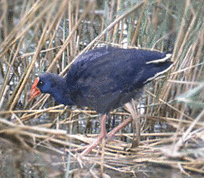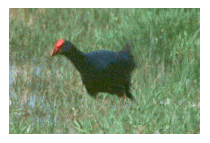Purple Swamp Hen - Best of Sicily Magazine (original) (raw)

 Since its oldest colour portrait appears in Sicily, as a mosaic in Piazza Armerina's ancient Roman villa (where two birds are depicted pulling a chariot), it seems appropriate that the Purple Swamp Hen should find a nesting place in Sicily following an absence of about forty years. Known to scientists as Porphyrio porphyriofor its deep blue --almost purplish-- plumage, the unique bird called thePollo Sultano (literally "Sultan Cock") in Italian andIaddu Fascianu in Sicilian migrates throughout the western Mediterranean coastal wetlands. This graceful Eurasian species is seen in Sardinia, Spain, Portugal and northern Africa, and has been watched as far north as Denmark, having been introduced in other parts of the world as well. As Sicily's wetlands diminished, so did the island's appeal to the Mediterranean's most beautiful bird. Thanks to extensive conservation efforts in Spain and elsewhere, it has been reintroduced into many of its former habitats. The Purple Swamp Hen grows to a length of around 47 centimetres with a wingspan up to a metre, weighing as much as a kilogramme (2.2 pounds), nesting among reeds and feeding on swamp vegetation and certain fish and small amphibians.
Since its oldest colour portrait appears in Sicily, as a mosaic in Piazza Armerina's ancient Roman villa (where two birds are depicted pulling a chariot), it seems appropriate that the Purple Swamp Hen should find a nesting place in Sicily following an absence of about forty years. Known to scientists as Porphyrio porphyriofor its deep blue --almost purplish-- plumage, the unique bird called thePollo Sultano (literally "Sultan Cock") in Italian andIaddu Fascianu in Sicilian migrates throughout the western Mediterranean coastal wetlands. This graceful Eurasian species is seen in Sardinia, Spain, Portugal and northern Africa, and has been watched as far north as Denmark, having been introduced in other parts of the world as well. As Sicily's wetlands diminished, so did the island's appeal to the Mediterranean's most beautiful bird. Thanks to extensive conservation efforts in Spain and elsewhere, it has been reintroduced into many of its former habitats. The Purple Swamp Hen grows to a length of around 47 centimetres with a wingspan up to a metre, weighing as much as a kilogramme (2.2 pounds), nesting among reeds and feeding on swamp vegetation and certain fish and small amphibians.
During the nineteenth century, it is estimated that around 1,500 of these graceful birds were killed in Sicily each year, particularly in the coastal marshlands in the southeastern regions of the island. Into the twentieth century, birds hunted near Lentini were often sold at market in Catania as though they were chicken or partridge. Now a protected species, the Purple Swamp Hen is being introduced in three reserves --Biviere di Gela, Foce del Simeto and Saline di Siracusa. With birds raised on a Spanish wildlife preserve near Valencia, the Italian government is sponsoring the programme through two agencies, the Italian Bird Protection League (LIPU) and the National  Institute for Wild Fauna (INFS). The only other Italian region where this species flourishes today is Sardinia. Isola delle Femmine and other Sicilian coastal preserves will be considered for future nesting places.
Institute for Wild Fauna (INFS). The only other Italian region where this species flourishes today is Sardinia. Isola delle Femmine and other Sicilian coastal preserves will be considered for future nesting places.
The chicks have dark plumage --almost black-- and young birds often stay with their parents for two years before flying off to nest. The adult birds sometimes migrate to other coastal marshes.
The Purple Swamp Hen project is an ambitious one representing a serious attempt to reclaim Sicily's marshlands in all their natural biodiversity. It's part of a larger Western Mediterranean movement to preserve this unique bird in its natural environment. This effort coincides with similar programmes in Portugal and several Spanish coastal Islands. Whether these initial efforts take flight remains to be seen, but they're off to a good beginning.
About the Author: Vincenzo Mormino is active in wildlife preservation throughout Sicily. This is his first article for Best of Sicily.